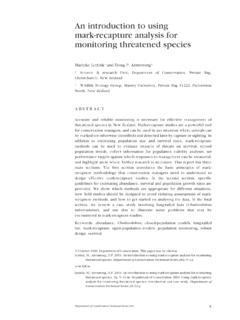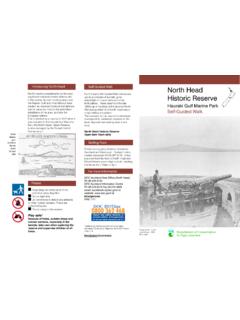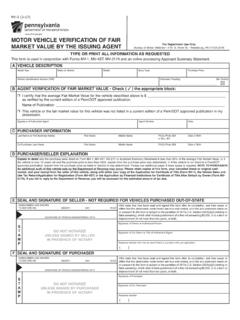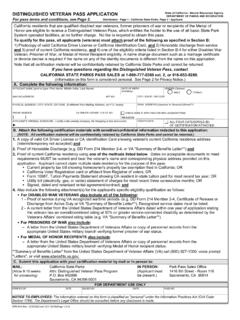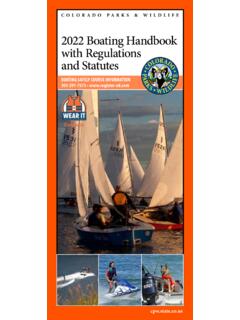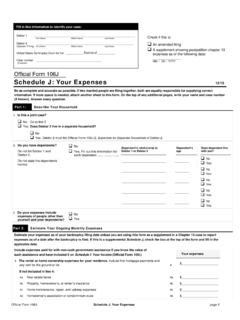Transcription of Walks in and - Department of Conservation
1 Further information:Tongariro National Park Visitor Centre State Highway 48 Whakapapa Village PO Box 71029 Mount Ruapehu 3951 PHONE: 07 892 3729 EMAIL: information was accurate at the time of printing. For the latest information on DOC s policies and facilities, visit by: Department of Conservation Tongariro National Park Visitor Centre PO Box 71029 Whakapapa Village Mount Ruapehu 3951 New ZealandEditing and design: Te R p Ratonga Auaha Te Papa Atawhai DOC Creative ServicesNovember 2022 This publication is produced using paper sourced from well-managed, renewable and legally logged photo: Tongariro Northern Circuit. Photo: DOC/90 SecondsCENTRAL NORTH ISLANDW alks in and around Tongariro National Park5657 Getting thereThis 78,618-hectare park, located in the central North Island, is bordered by State Highways 1, 49, 4 and 47. The nearest towns are T rangi, National Park and Ohakune. The small village of Whakapapa is located within the main trunk railway runs through National Park and Ohakune townships.
2 Regular bus services operate to Ohakune, National Park and T rangiTongariro National Park Visitor Centre25kmContentsTongariro National Park World Heritage AreaThe Sacred Tuku 1887 ..1 Introduction ..3 Tongariro National Park Visitor Centre ..3 Know before you go ..4 Camping ..8 Huts ..8 Plan and prepare ..10 Tracks and Walks ..12 Whakapapa ..13 Walks (less than 3 hr) ..13 Day tramps (3 8 hr) ..20 Ohakune ..22 Walks (less than 3 hr) ..22 National Cycle Trail: Ruapehu Whanganui Trails ..25 Day tramps (3 8 hr) ..29On and near Mount Tongariro ..30 Walks (less than 3 hr) ..30 Day tramps (3 8 hr) ..31 Further afield ..34 Walks (less than 3 hr) ..34 Day tramps (3 8 hr) ..35 Multi-day tramping tracks ..36 Round the Mountain ..37 Tongariro Northern Circuit Great walk ..44 Backcountry travel in Tongariro National Park ..48 Tongariro s unique flora and fauna ..50 Protecting our natural heritage ..54 MapsWhakapapa enlargement ..14 Ohakune enlargement ..23 Ruapehu Whanganui Trails.
3 27 Tongariro National Park .. fold-out back cover5859 Tongariro National Park World Heritage AreaThe Sacred Tuku 1887 Horonuku Te Heuheu T kino IV (Paramount Chief), Matuaahu Te Wharerangi and other rangatira of Ng ti T wharetoa, one of the tribes with mana whenua (occupational authority) over the land in this region, extended the kaitiakitanga (custodianship) of the peaks of Tongariro, Ng uruhoe and part of the peak of Ruapehu to the people of Aotearoa New Zealand on 23 September 1887. Described as a Tuku (an offer of shared kaitiakitanga), iwi would, through a partnership with the Crown, ensure that the landscape and cultural values of the North Island mountains would be protected for all (M ori tribes) had always held land on a communal basis. Horonuku, Matuaahu and the other rangatira did not want to see the sacred mountains of their people divided into blocks and sold to land-seeking settlers. Loss of this land would mean loss of the sacred volcanoes and a loss of mana (status, prestige, integrity) for Ng ti T wharetoa, Ng ti Rangi and Whanganui iwi who all have mana whenua of the mountains.
4 Remember, if you are not experienced and equipped for alpine hiking, we recommend that you choose a track below the bushline where alpine experience is not required, or go with a guide. To book a guide, contact your nearest i-SITE, or visit or your safetyWhen visiting Tongariro National Park, always follow the Land Safety Code. f Choose the right trip for you Learn about the route and make sure you have the skills for it. f Understand the weather It can change fast. Check the forecast and change your plans if needed. f Pack warm clothes and extra food Prepare for bad weather and an unexpected night out. f Share your plans and take ways to get help Telling a trusted person your plans details and taking a distress beacon can save your life. f Take care of yourself and each other Eat, drink and rest, stick with your group, and make decisions further information, visit Alpine Crossing. Photo: Graeme Murray1An Act of Parliament formally established Tongariro National Park in 1894 and it was gazetted as such in 1907.
5 The original tuku area of 2360 hectares has been increased over the years by government procurement of surrounding land to create a national park of 78,618 to the insight of Horonuku, Matuaahu and other Ng ti T wharetoa rangatira, Tongariro National Park was the first national park in Aotearoa New Zealand and the fifth in the world. While the mountains have been protected, and are recognised as a World Heritage site, the mana whenua feel that the Tongariro National Park Act 1894 has not adequately recognised the intent of the Tuku as an expression of shared kaitiakitanga and management of the mountains. The mana whenua would like to restore the partnership intended by the 1887 Tuku by making a new partnership arrangement for the National our mountains of Tongariro are included in the blocks passed through the court in the ordinary way, what will become of them? They will be cut up and sold, a piece going to one P keha and a piece to another. They will become of no account, for the tapu will be gone.
6 Tongariro is my ancestor, my t puna, it is my head; my mana centres around Tongariro. You know how my name and history are associated with Tongariro, I cannot consent to the court passing these mountains through in the ordinary way. After I am dead, what will be their fate?Te Heuheu T kino IV, 1885 National parks represent glimpses of our environment as it once was, and also form cultural icons connecting people to the land. The varying landscape of Tongariro National Park features herbfields, forests, lakes, streams and desert-like areas, as well as dramatic terrain formed by volcanic activity. The landforms, volcanoes and ecosystems of Tongariro National Park are now recognised as having outstanding international significance and have been awarded UNESCO dual World Heritage status for natural and cultural National Park Visitor Centre Call in to the Tongariro National Park Visitor Centre, situated in Whakapapa Village, and meet Department of Conservation Te Papa Atawhai (DOC) rangers who have first-hand, in-depth local knowledge about Conservation places and activities.
7 The centre is open every day (except for Christmas day) from 8 am to 5 pm during the summer season and 8 am to pm during the winter season. Hut tickets, hut passes and topographical maps are available for sale, as well as books, souvenirs, clothing and a selection of outdoor safety items. A foyer is open 24 hr for access to a public telephone, weather and avalanche reports, and track : 07 892 3729 Email: on the park is also available from the i-SITES in: Ohakune 06 385 8427 Taumarunui 07 895 7494 T rangi 07 386 8999 Taup 07 376 0027 Introduction32 Weather The climate of Tongariro National Park is highly unpredictable and changes quickly. High levels of rain and very cold temperatures are common, and snow is possible at any time of the year. Check the latest weather forecast and track conditions before starting out on any hikes, and always be prepared for bad weather. For the latest weather forecast, check at the Tongariro National Park Visitor Centre or visit crossingsHeavy rain will cause increased water flow in all streams and rivers in the park.
8 At these times, unbridged rivers may become difficult or impossible to cross, particularly those on the longer Walks such as the Round the Mountain and Whakapapaiti Valley tracks. If you come across a swollen river, do not cross it. Turn back or stop and wait for the river to hazardsOne of the main reasons Tongariro National Park is considered a special area is because of its volcanic features. Although volcanic events are often spectacular to view at a safe distance, there can be considerable risk for those who venture close to the active should be aware that volcanic activity is possible in the area at any time with little or no warning. Anyone intending to hike or climb on the upper slopes of the volcanoes should first check the current volcanic status and safety information for the area. During times of volcanic activity, hikers and skiers should move away from the crater and onto high ground to avoid flying rocks, lahars and blasts. Check Geonet for the volcanic status: before you goLahar hazards on Mount RuapehuMount Ruapehu is an active volcano.
9 An eruption may generate lahars (volcanic floods and mudflows) in major valleys and in the Whakapapa Ski Area. Hikers and skiers should familiarise themselves with known lahar paths and be prepared to move out of valleys should an eruption Ng uruhoe eruptionIncandescent lava blocks, some the size of small cars, leave vapour trails in the sky. Some of the heavier material begins to drop, causing fluid pyroclastic flows (glowing avalanches of fragmented rock) travelling 2 km from the crater down the Mangatepopo Ng uruhoe eruption. Photo: DOCSnow and avalanchesThroughout the year, tracks in the park may be affected by snow and ice. In these conditions, hikes may take longer than the posted track times. Be aware of avalanche danger after heavy snowfalls. Before you set out, check information on the current snow stability at the Tongariro National Park Visitor Centre or visit Treat snow slopes in the lee (downwind) aspect of recent winds and ice slopes as high hazard areas.
10 Throughout winter, ice axes and crampons (and the experience to use them) are required for tracks in the alpine areas of the park. Visitors must be able to make their own on-site assessments of weather, route and avalanche conditions, and should carry an avalanche transceiver, probe and shovel if venturing into snow-covered areas. It is recommended that visitors who are not equipped for or experienced in alpine conditions go with a National Park is a volcanic zone and high mineral concentrations are present in many of its waterways. Giardia may also be present in some streams in the park. We recommend you boil all drinking water for at least 3 min. Water from the upper Mangatepopo Stream, Emerald Lakes and Ketetahi Hot Springs is not suitable for drinking due to its high mineral content. In times of volcanic activity, water tanks at huts may be disconnected to avoid ash contamination, and streams and rivers could also become contaminated. Visitors should carry their own water cultural and health reasons, swimming is not advised in many of the lakes, streams and rivers of the park.
